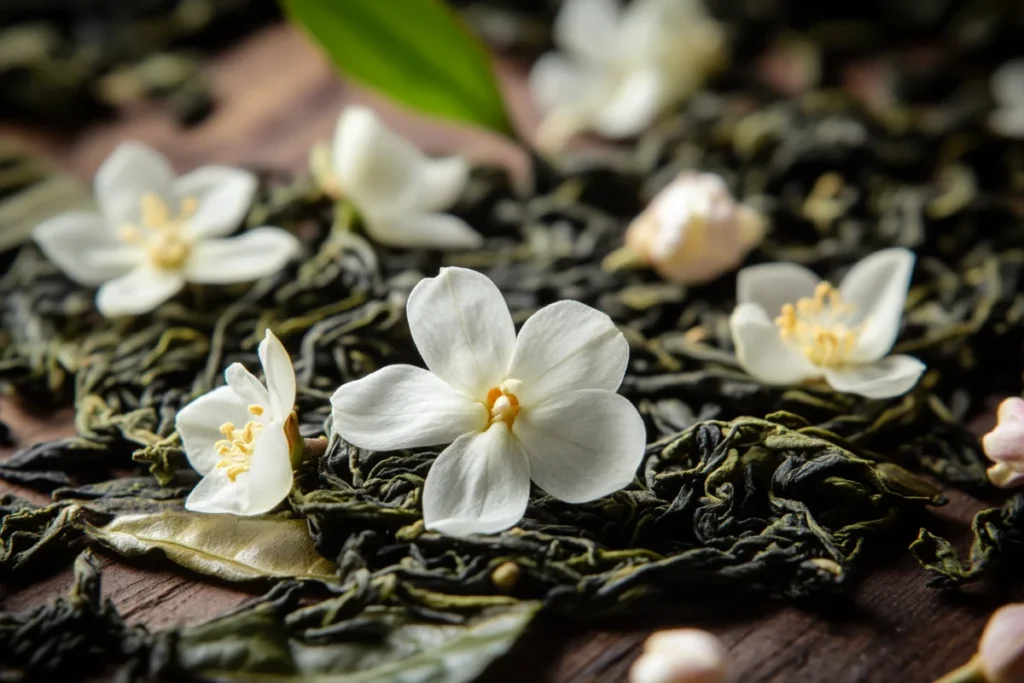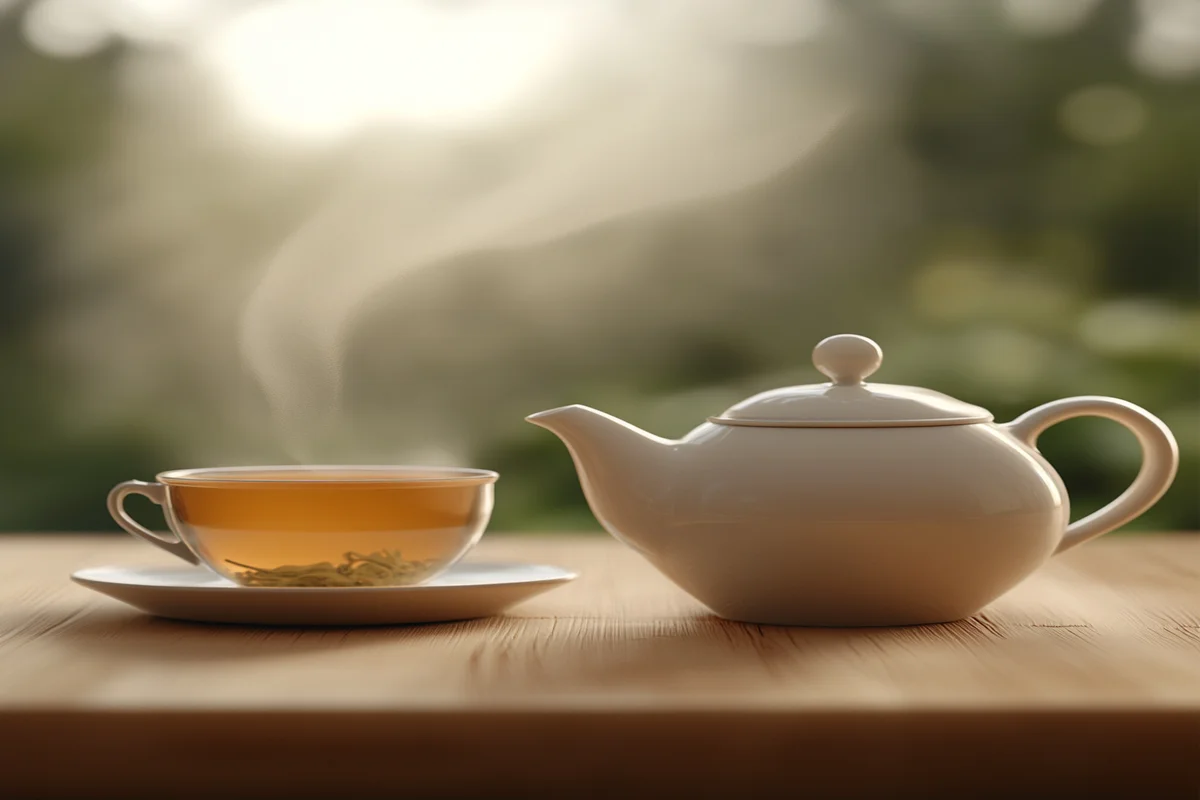Introduction
Jasmine tea is a timeless favorite among tea enthusiasts. Indeed, it captures the fragrant essence of jasmine blossoms and blends it with the comforting warmth of fine tea leaves. Moreover, many people adore this floral infusion for its soothing taste and exquisite aroma. In this guide, we will explore its history, flavors, and brewing techniques. Additionally, we will look into organic varieties, discuss potential health advantages, and highlight why it appeals to both casual sippers and seasoned connoisseurs.
In recent years, people have become increasingly health-conscious. Consequently, they seek out drinks that offer both flavor and wellness perks. The jasmine-scented beverage fits perfectly into this trend. Specifically, it provides a refreshing alternative to many sugary drinks. Furthermore, its floral profile appeals to those who enjoy delicate flavors rather than robust or bitter notes.
Jasmine tea: Why Is This Scented Brew So Popular?
Sipping this fragrance-filled drink is more than a simple thirst-quencher. Rather, it can be a way to relax and tune into the world around you. In many cases, whether you prefer green, black, or white tea as a base, the underlying principles remain the same. In essence, leaves are scented multiple times with freshly picked jasmine flowers. Ultimately, this careful process ensures that the floral aroma seeps deep into the tea, resulting in a fusion of taste and fragrance that stands out among aromatic options.
In this article, we will delve into several critical topics:
- Scented tea essentials
- What are the benefits of this floral blend?
- How to brew it properly?
- Is it good for weight loss?
- Best brands to try
- How does it compare to plain green tea?
By the end, you will be equipped with all the details you need to pick an excellent jasmine-scented option and brew a cup that maximizes its wonderful aroma and flavor.
Jasmine Tea Essentials
This scented tea stands apart in the tea world because of its distinctive layering process. Historically, the beverage has ancient roots in China, where artisans discovered that combining jasmine flowers with top-quality leaves created an aromatic masterpiece. Most often, green varieties are the go-to base for scenting, but white or black leaves are sometimes used as well.
A Glimpse into History
Tea historians suggest that this floral creation has been around for many centuries, possibly as far back as the Song Dynasty. Initially, production was reserved for royalty and high-ranking officials. Over time, the fragrant brew became more accessible to the public. Despite its age, the methods of preparing top-tier scented tea have stayed remarkably consistent. Indeed, producers continue to carefully harvest fresh blossoms at night, layering them with green leaves until those leaves fully absorb the fragrance.
The Role of Jasmine Green Tea
While you can technically use different types of leaves, jasmine-scented green tea remains the most popular. Notably, green tea has a natural sweetness and lightness that pairs exceptionally well with floral undertones. Moreover, it retains more antioxidants compared to darker types, which enhances potential health benefits. Hence, many enthusiasts say this infusion can support both mind and body.
Selecting High-Quality Leaves
If you want a premium brew, choosing top-tier leaves is vital. Typically, connoisseurs insist on spring-harvested leaves because they yield a fresh, smooth taste. Often, these high-grade leaves are combined with newly opened blossoms, resulting in a drink with nuanced layers of sweetness and aroma.
You can find a wide range of options on the market, from mass-produced bags to artisanal loose-leaf blends. Additionally, organic options are growing in popularity, appealing to those who want the purest, most natural version of their beverage. Because organic certifications often imply that the tea was grown without synthetic chemicals, you can enjoy a clean taste with fewer environmental impacts.
The Scenting Process
The hallmark of authentic jasmine-themed blends is the scenting step. Specifically, tea leaves and flowers are interlaced in thin layers. As night falls, blossoms release their fragrance, allowing the leaves to capture the floral essence. This practice is sometimes repeated multiple times, each repetition resulting in a deeper aroma. Eventually, once the leaves have fully absorbed the fragrance, the spent flowers are removed to prevent bitterness.
Enjoying This Floral Infusion at Home
Brewing at home can be a relaxing ritual. Whether you opt for loose leaves or tea sachets, the key is to preserve the delicate aroma. In the following sections, we will show you how to do this with simple steps and best practices.
Jasmine tea: What Are the Benefits of This Scented Drink?
Potential perks of this infusion are often discussed among health enthusiasts. While studies vary, many support the idea that it can be good for overall wellness. Below are some possible advantages.
Rich in Antioxidants
Green-based blends and other variations (white or black) contain polyphenols. Importantly, these compounds help neutralize harmful free radicals in the body. If left unchecked, these free radicals can contribute to aging and certain health issues. Therefore, by consuming a tea rich in antioxidants, you may support your body’s ability to ward off oxidative stress.
Supports Relaxation
The floral scent of jasmine can have a calming effect on the mind. Often, people use it for stress relief or to lift their mood. Combined with tea’s gentle caffeine content, the aroma can promote an alert yet calm mindset. Hence, many enjoy a cup when they need focus without the jittery effects of coffee.
Potential Heart Health Perks
Drinking tea in moderation may also support cardiovascular health. Some researchers link regular consumption to better cholesterol balance and improved blood vessel function. Nevertheless, more studies are needed before drawing firm conclusions.
Digestive Aid
Some drinkers find that a cup of this scented infusion after a meal helps soothe digestion. Specifically, the warmth can ease discomfort, and the tea’s mild astringency may aid in balancing gut flora. Of course, everyone’s experience differs, so it is wise to pay attention to your own body’s reactions.
Aromatherapy Aspect
Even the simple act of inhaling jasmine’s scent can be beneficial. Aromatherapists often use jasmine for relaxation, mood elevation, and even a mild aphrodisiac effect. Thus, enjoying this fragrant brew allows you to combine aromatic qualities with the soothing act of tea drinking.
Keep in mind, individual responses vary, and you should always consult a healthcare professional for personalized advice, especially if you have underlying conditions or sensitivities.

How to Brew It Properly?
How to brew this scented green properly is a frequent question. Indeed, technique can make or break your experience. Therefore, follow these steps to ensure every cup highlights the floral charm and avoids any harshness.
Step 1: Choose the Right Tools
A ceramic or glass teapot is often recommended. Crucially, these materials do not retain flavors, helping you keep a pure taste. If you use a metal infuser or pot, it can sometimes impart an unwanted metallic note.
Step 2: Measure Your Leaves
As a general guideline, use about one teaspoon of loose leaves per cup (roughly 8 ounces of water). However, adjust this based on the specific instructions on your package and your personal taste preferences.
Step 3: Temperature Matters
Green-based blends usually steep best at around 175°F to 185°F (80°C to 85°C). Importantly, using boiling water can scorch the leaves, leading to a bitter, unpleasant flavor. If you do not have a thermometer, bring water to a boil and let it cool for a minute or two.
Step 4: Steep Time
Steep for about 2 to 3 minutes initially. If you prefer a stronger brew, allow an extra 30 seconds to 1 minute. Be mindful that over-steeping leads to bitterness, while under-steeping might result in a watery flavor.
Step 5: Enjoy the Aroma
Before sipping, take a moment to inhale the steam. Clearly, the floral scent is a big part of the experience. Hence, you will notice sweet, blossom-like notes wafting up from the cup, offering a mini aroma-therapy session.
Step 6: Experiment with Multiple Infusions
High-quality leaves can often be steeped multiple times. Notably, each infusion may reveal different layers of flavor. Simply add slightly more time for each subsequent steep, and lower the water temperature a bit to maintain consistency.
By following these tips, you preserve the drink’s delicate flavor while extracting the essence of jasmine. Feel free to experiment with steeping times and temperatures until you find the perfect cup.
Is This Drink Good for Weight Loss?
Many wonder whether it can aid in shedding pounds. While no single beverage can guarantee weight loss, a jasmine-scented infusion can be part of a balanced lifestyle. Here are some ways it may support your goals:
- Caffeine and Metabolism
The moderate caffeine present might give a mild boost to your metabolism. Even though this effect is small, it can be advantageous if combined with an overall healthy routine. - Low-Calorie Beverage
The infusion is naturally low in calories when consumed without added sugar or cream. Therefore, substituting calorie-laden soft drinks with this floral brew can help you reduce your daily calorie intake. - Mindful Drinking
A slow, deliberate approach to sipping often deters mindless snacking. Thus, the ritual can help you tune into your body’s hunger and fullness signals. - Antioxidant Support
Antioxidants in the tea might help your body deal with oxidative stress. In some research, this stress is linked to weight management challenges. Hence, reducing it may help maintain a healthy weight.
In short, drinking this brew alone will not cause significant weight loss. Instead, combine it with balanced nutrition, exercise, and proper rest to see meaningful results.

Best Brands to Try
Tea enthusiasts often spend time experimenting with different brands to discover which option best delivers on flavor and aroma. Indeed, brand choice can significantly affect your experience. Below are some pointers for finding top-quality offerings and why organic sourcing may be worthwhile.
Quality Indicators
- Origin: Many premium scented teas come from Fujian province in China. Because of the region’s climate and expertise, the leaves often boast superior taste.
- Harvest Time: Look for products that specify early-spring or first-flush harvests. Typically, these harvests yield smoother, more fragrant leaves.
- Scenting Method: Some brands detail the number of scenting cycles they use. Often, multiple scentings result in a more potent floral aroma.
Organic Benefits
Opting for organic can bring advantages for you and the environment. Generally, organic farming practices avoid synthetic pesticides. Consequently, the leaves might have fewer chemical residues. Additionally, sustainable methods are kinder to soil health and biodiversity.
Where to Start
- Well-Known Tea Houses: Established companies often maintain stringent quality control. Thus, they may carry options that clearly list origin and scenting details.
- Local Specialty Shops: If you have a local vendor, you can sample small amounts before committing to a larger purchase. This approach lets you smell and perhaps taste the tea.
- Online Retailers: A wide variety of reputable sellers exist online. Frequently, they offer extensive product details, flavor profiles, and customer reviews, which can help you narrow your choices.
In many cases, experimenting is half the fun. You might find one brand that offers a robust floral flavor, while another yields a softer, more subtle experience. By keeping tasting notes, you will eventually discover a brand that truly suits your palate.
Jasmine-Scented vs Plain Green Tea – Which Is Healthier?
Comparing jasmine-scented tea vs plain green tea can be tricky, because the scented version often uses green tea as its base. Essentially, this infusion is green tea enhanced with jasmine blossoms. Therefore, the core health properties remain, but you gain the added floral aromatics.
Overlapping Health Benefits
Green tea is known for its antioxidants, most notably catechins. Because a jasmine-based option typically starts with green leaves, it also contains these beneficial compounds. Hence, many of the health attributes overlap.
Aromatic Edge
What sets the scented variety apart is its floral bouquet. If you enjoy delicate fragrances, the jasmine version might be more appealing. Additionally, the scent can add to the calming effect often associated with tea. Conversely, those who dislike floral flavors may prefer straight green tea.
Caffeine Content
Both versions typically contain moderate levels of caffeine. However, the difference depends more on the specific leaves and steeping time than on the added fragrance. If you are sensitive to caffeine, opt for decaffeinated versions or reduce steep time.
Flavor Profiles
- Green Tea: Vegetal, slightly grassy, sometimes with a light bitterness
- Jasmine-Scented: Light and sweet, with floral undertones
In general, it is less a question of health differences and more one of flavor preference. Both can be beneficial, providing antioxidants and other potential perks. If you appreciate a fragrant twist, the scented choice may be your wonderful option. Otherwise, straightforward green tea might be your go-to.
Conclusion
This blossom-infused beverage remains a remarkable fusion of scent and flavor that has captivated tea lovers for centuries. From selecting the best brand to perfecting your brewing technique, each step can elevate your tea ritual. Clearly, using green leaves scented with jasmine offers a harmonious flavor profile and potential health rewards. If you opt for organic, you might also enjoy peace of mind regarding sustainability and purity.
We have explored various facets of this infusion, including its soothing aroma, antioxidant properties, and possible role in weight management. Likewise, we have answered key questions about brewing, brand selection, and how it compares to plain green tea. While there is still plenty to learn, you now have a solid foundation to begin your journey toward the perfect cup.
Ultimately, tea drinking is a personal experience. You might prefer a single-origin variety with an elegant scent, or you could gravitate toward a more robust, multiple-scented blend. Regardless, there is no wrong choice—only the joy of discovery, one sip at a time.
FAQ
What is jasmine tea made of?
It is typically made of tea leaves—often green—scented with fresh jasmine blossoms. Specifically, the flowers are layered with the leaves multiple times so they absorb the floral aroma. Eventually, once scenting is complete, the spent blooms are removed.
Does this floral brew have caffeine?
Yes, it usually contains caffeine because it uses leaves from the Camellia sinensis plant. In most cases, the green variety has moderate caffeine levels. Nevertheless, brewing methods, water temperature, and steeping times can affect the final caffeine content.
What does it taste like?
The overall flavor is light and floral. Because its base is often green tea, the result is a gentle grassy note combined with aromatic blossom undertones. Overall, it tends to be smooth, with a well-balanced fusion of sweetness and subtle vegetative hints.
How do you brew it correctly?
Heat water to about 175°F to 185°F (80°C to 85°C) and steep one teaspoon of leaves per cup for 2 to 3 minutes. If you prefer a stronger brew, you can extend the time slightly. Just be cautious, as boiling water directly on the leaves can cause bitterness. You can also resteep them multiple times for evolving flavors.
In practice, pay attention to temperature and steep duration, as green varieties are delicate. For instance, letting water cool slightly after boiling helps prevent scorching. Similarly, adjusting the amount of tea leaves can alter intensity. Moreover, experimenting with multiple infusions can offer a more complex flavor journey. By following these suggestions, you can brew a cup that captures its fragrant charm without overpowering flavor.
For more recipes: https://meritrecipes.com/milk-tea-benefits-recipes/

